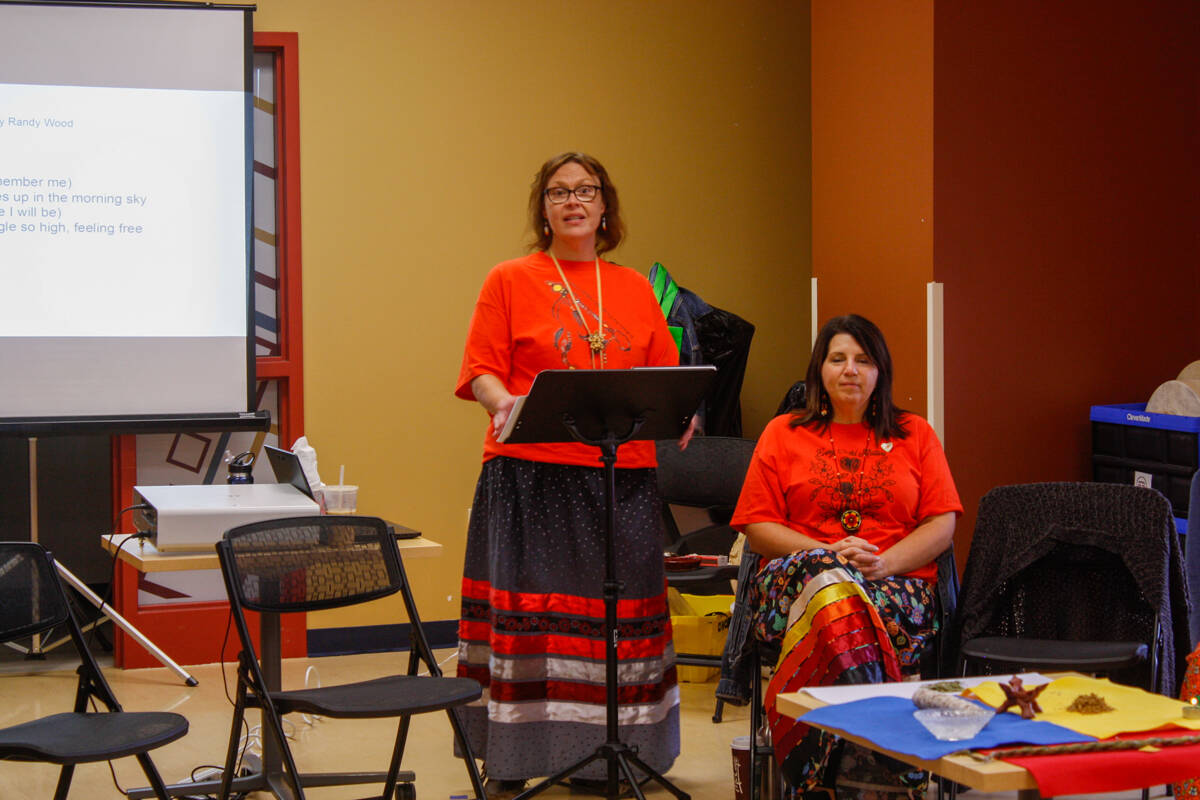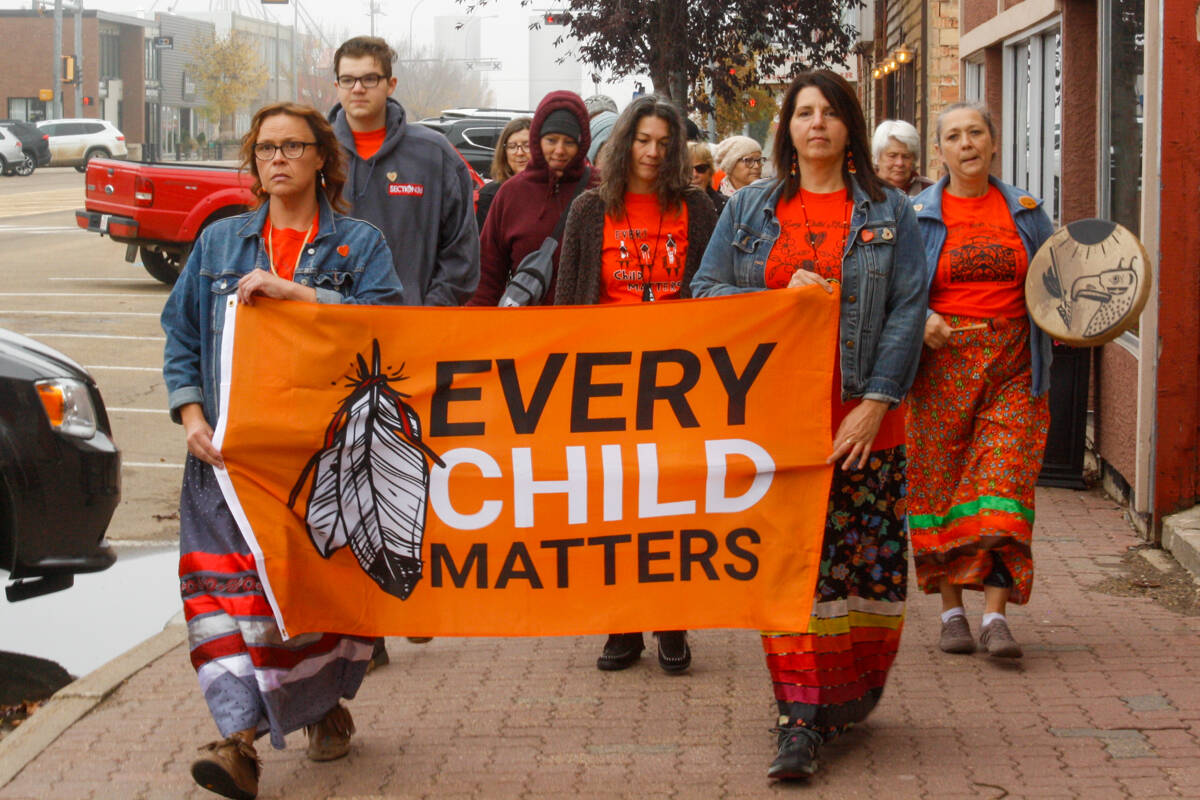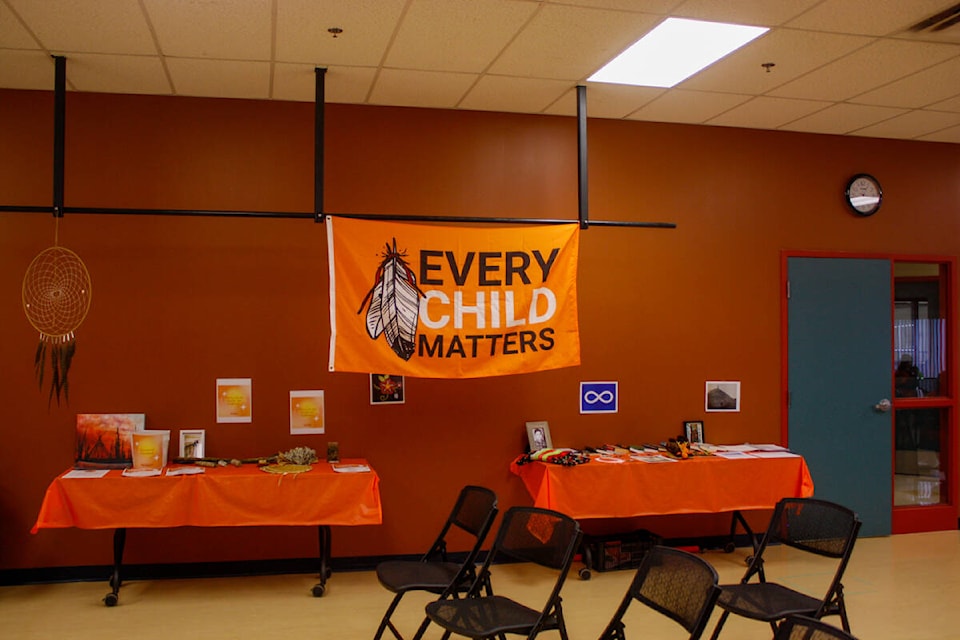By Carson Ellis For the Independent
September 30 is recognized as the National Day for Truth and Reconciliation Day with events taking place all across the country, all with the intention of bringing attention to the complex issues surrounding the culture and histories of Indigenous people in Canada.
The Stettler Friendship Circle hosted a series of events throughout the day to mark the nationwide event.
The day started with a historical nature walk at 9 a.m. This was later followed by a walk along both sides of Main Street. Members of the circle carried an Every Child Matters flag and marked the event with accompanying drumming.
They were joined by several members of the community who were out on the damp, cool morning to support the event.
Events then moved indoors, starting at 1 p.m. with a Traditional Indigenous Learning session.
Friendship Circle member Deanna Lindstrom addressed visitors who sat in a circle, explained many aspects of Indigenous culture and talked about her experiences over the last several years as she has been learning and experiencing her Indigenous heritage.
Lindstrom explained how her heritage wasn’t talked about growing up. She said that while she’s learned more about her heritage, she has come to believe that although there are many different Indigenous cultures, many people have different experiences.
Lindstrom continued that she feels this doesn’t make one person’s experiences less than another’s and says that everyone’s “Commonalities are all basic truths.” She explained that her grandmother went to extreme lengths to keep him from being sent to a residential school.
Lindstrom then explained the four sacred medicines of Indigenous culture, and what each of them represents. The four medicines are tobacco, sage, sweet grass and cedar. Lindstrom spoke of how each of these medicines is used for ceremonies and the traits that they have in Indigenous culture.
She continued how they were also represented by colours in what is called a medicine wheel, and how the colours vary from one culture to the next. For example, while the use of the colour black had different meanings in some cultures, it was not used in represent the medicine wheels of others.
After Lindstrom’s presentation, there was an invited speaker following which was a short break before a healing ceremony conducted by Loretta Lavallee.
Afterwards, participants were invited to join members of the Stettler Friendship Circle in a special viewing of the film Bones of Crows, the story of a Cree woman named Aline Spears who survived the Canadian Residential School system and the events following her experiences.
Lee Hamelin
As part of the National Day for Truth and Reconciliation events held in Stettler, there was a presentation by long-time resident Lee Hamelin. Hamelin is a survivor of what is commonly referred to as the 60’s Scoop, which was a systematic removal (or scooping) of Indigenous children across Canada during most of the 1960s. Hamelin was born in High Prairie and was four years old when he and his seven-year-old brother were removed from their home, which had been deemed ‘neglectful’ by local authorities.
Hamelin explains that he had other siblings who had not been removed from the home, most likely due to their age, although he says that is an unusual factor if the house was deemed neglectful.
Hamelin explains that the term 60s scoop was coined by Patrick Johnson in his 1983 report about Native Children and the Child Welfare System. Johnson did note that many of the removals, or ‘scooping’ of Indigenous, children who were then placed into the welfare system were justified, however many were not. It is estimated that 20,000 children were ‘scooped between the 60s and the 80s.
Many by force
Hamelin went on to talk about life with his brother in a devoutly Christian home. He notes that “even until today, the Native culture that was my life was almost extinguished.” Hamelin is clear and understanding of his situation being ‘unique’ compared to others. He says that he and his brother were taught how to work and how to succeed in life. They were taught right from wrong. He says that he was placed in a white family that was very loving and kind to them; he understands not everyone was put into the same situation.
Many who were scooped were abused, shuffled from home to home and used as farm workers. Many were also sold to people in the US or abroad.
Hamelin says that he was raised in a Christian household and held strongly to the beliefs. He says as he grew older, his religious convictions were his to control.
This was not the case for the thousands who were forced into residential schools or those placed in other homes.
In his presentation, he touched on the poor conditions of residential schools. The abuses, physical, sexual, mental and emotional, were inflicted as well as the tainted food supplied to many schools, poor education given to the students, and other problems faced by the approximately 150,000 students in the 150 years of residential school history.
Hamelin is thankful for the fact that he and his brother, whom he refers to as his protector, were educated and well cared for in a loving environment. However, he notes that while he was attending school, he had relatives just down the street from him that he was never made aware of. Some of them were cousins the same age as himself.
Hamelin says “We as a proud people are on the rebound.” He notes that Indigenous people are business owners and territorial land owners bringing in revenues for local bands, and communities. Languages that were on the verge of extinction have been revived. He notes that Aboriginal communities are now the fastest-growing population in Canada.
There are Native law enforcement, lawyers, doctors, nurses, professors, judges, and politicians and a Native Attorney General of Canada and Supreme Court Justice.
Hamlin knows the ongoing struggle against discrimination and racism will continue. He notes that “what is truth” is a question that poses many more questions. He says it is important to discuss these things at the dinner table, and beyond. He notes that despite the 94 recommendations laid out by the Truth and Reconciliation Commission having yet to be implemented by the Federal Government, it is important to note that four things must occur for reconciliation to happen.
• Awareness of the past
• Acknowledgement of the harm it has inflicted.
• Atonement for the causes.
• Action to change behaviour
~Editor’s note: This story was edited for grammar and modified to remove certain aspects of private information shared during the day which was never intended for publication at the request of organizers. We apologize that it was included in the initial story.


